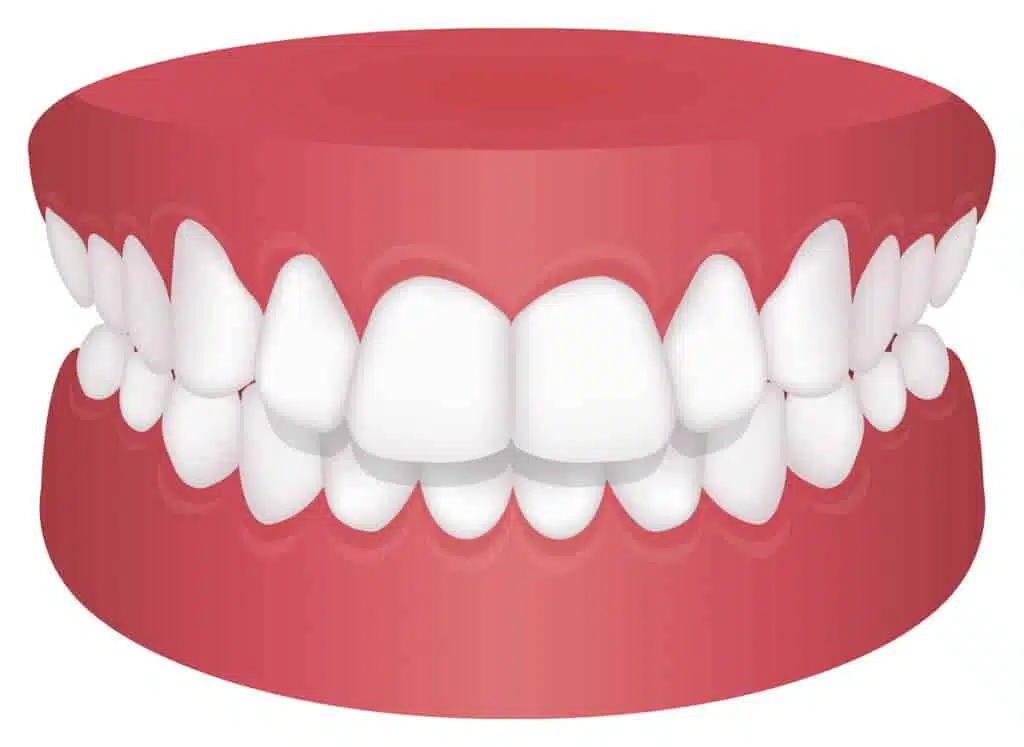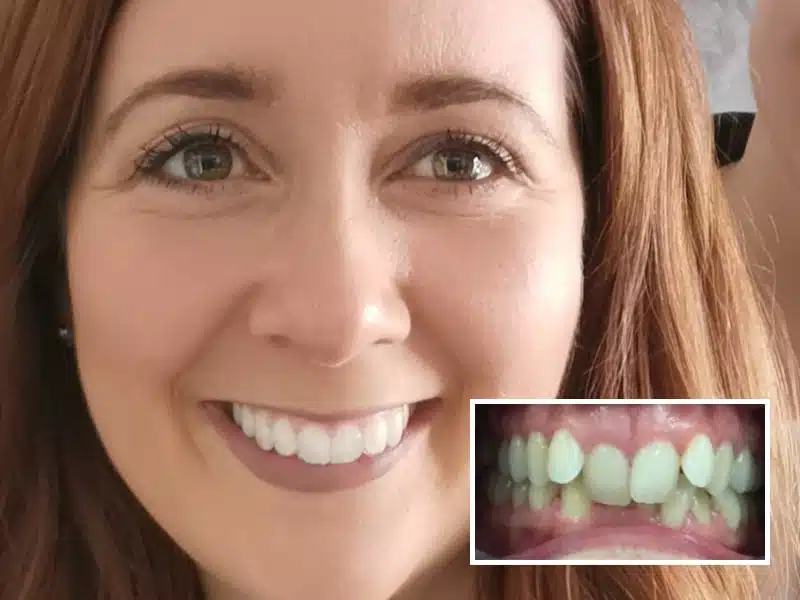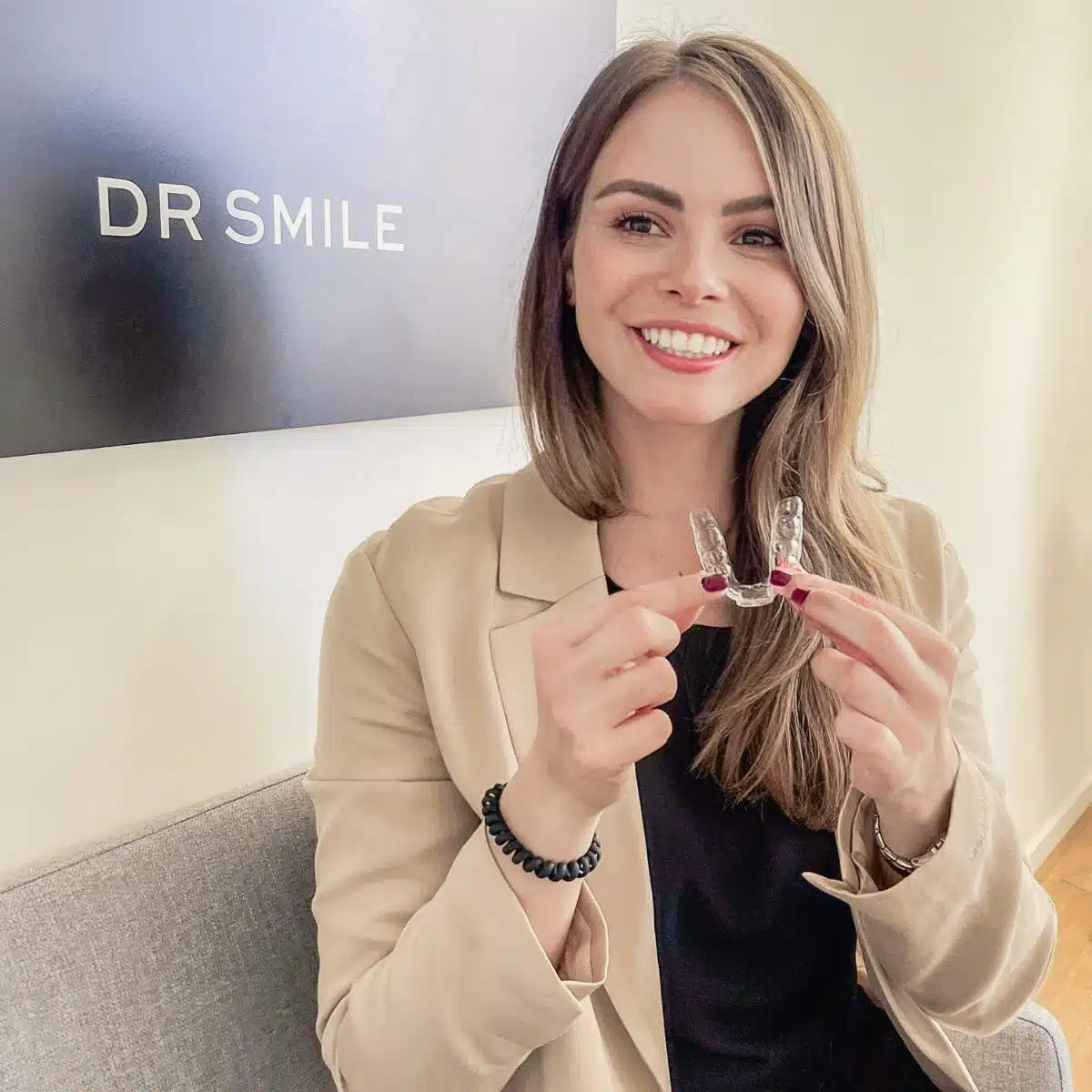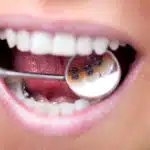Would you like to have your overbite treated? Then you’ve come to the right place. In this article, you will find all the important information about the malocclusion itself and the overbite treatment.
Dentists and orthodontists speak of a so-called malocclusion whenever one or more teeth are outside the ideal dental arch shape of the upper or lower jaw.
For example, they may be rotated, the teeth may be forward or backward, or they may simply not grow out where they should.
Most tooth misalignments have only aesthetic effects. This means that although they disturb us visually, they do not negatively affect our health.
| Get 150 € discount on your dental correction! |

Book a consultation appointment now at a nearby DrSmile partner practice and find out if teeth straightening with aligners is right for you.
The appointment is completely non-binding and does not involve any costs.
With the code “THATSMILE150” you will receive 150 € discount on the treatment.
In some cases, however, crooked teeth can negatively affect food intake and cleaning of the teeth, or even lead to speech disorders (e.g. lisp).
In rare cases, serious health consequences can even result from serious tooth misalignments.
A relatively common malocclusion is the so-called overbite. This is a malposition of the upper jaw.
This is often relatively harmless and only in rare cases needs to be treated for health reasons.
You can find more information on the topic of overbite and treatment options in this article.
Here you can also find out whether discreet treatment with invisible braces (aligners) is possible.
You want to know directly? Then make a free and non-binding consultation appointment here.
You can find a first overview of all malocclusions here.
Many patients have already had their misaligned teeth successfully treated with invisible dental splints. Take a look at their before/after pictures here.

Overbite profile: what exactly is it?
Important to know: An overbite does not always have to be a malocclusion. Because in fact, a slight overbite in the jaw is absolutely normal and present in almost all of us.
Dentists and orthodontists actually only speak of malocclusion when the overbite significantly exceeds the normal range.
The technical term for the overbite is “prognathism”. A distinction is made between horizontal and vertical overbites.
We speak of a horizontal overbite whenever the upper jaw is too far forward and the lower jaw too far back.
In this so-called overjet, either the lower jaw is too small in relation to the upper jaw or vice versa. The upper and lower incisors are then too far in front of the other incisors.
There is therefore a noticeable gap, which most of those affected perceive as a visual restriction.
This intermediate space is also referred to as the “anterior tooth step”. In normal dentition, it should only be about 2 millimeters – but in the case of a severe overbite, it is considerably more.
In many cases, the horizontal overbite is associated with a vertical overbite . This is called overbite and ensures that the lower incisors are clearly visibly covered by the upper incisors.
For example, an overbite may look like this:

Overbite causes: How does the malocclusion develop?
An overbite can be either genetic or acquired or encouraged by various habits.
The latter include, for example:
- Thumb sucking
- Pacifiers (pacifier overbite)
- Tongue depressors
- Nail biting
- Chewing on pens
It is caused either by a malocclusion of the teeth (dental overbite) or by a malocclusion of the jaw (skeletal overbite).
Dental overbite is when the problem exists at the tooth level. In this case, for example, the axis of the incisors is not correct or the teeth are too close together.
A skeletal overbite, on the other hand, can result from irregular or faulty development of the jawbone.
| Get 150 € discount on your dental correction! |

Book a consultation appointment now at a nearby DrSmile partner practice and find out if teeth straightening with aligners is right for you.
The appointment is completely non-binding and does not involve any costs.
With the code “THATSMILE150” you will receive 150 € discount on the treatment.
What health effects can an overbite have?
As already mentioned, all people have a slight overbite. However, this does not have a negative effect on the appearance and the rows of teeth still appear harmonious.
However, a pronounced overbite can lead to various restrictions and influence the cooperation of tendons, muscles and joints.
Possible health consequences or overbite symptoms may include:
- An overload of the affected tissue and teeth. This is often not directly noticeable. As a result of the incorrect pressure load, however, the teeth can shift or tilt, resulting in teeth that protrude forward or teeth that protrude backward.
- The risk of injury to the upper incisors increases.
- Teeth and jaw joints can wear out faster because they are constantly misloaded.
- Headaches and muscle tension may occur.
- In some cases, there are problems and pain when biting and chewing.
- Closing of the mouth may also be affected. The incisors are then no longer sufficiently flushed with saliva, which increases the risk of caries.
- Speech problems can be a consequence if the overbite causes the palate, lips and jaw to not work together ideally.
- Last but not least, the visual impairment can lead to psychological consequences if the malocclusion affects the shape of the face or causes “buck teeth” (front teeth protruding forward). Malicious tongues even speak of a horse bit.
When should an overbite be treated?
Dentists and orthodontists always speak of a malocclusion when a deviation from the normal range is exceeded or undershot.
The vertical and horizontal overbite should be between two and four millimeters in a normal dentition.
Between four and eight millimeters is a so-called deep overbite . We talk about a severe overbite when the overbite exceeds nine millimeters.
However, experts recommend orthodontic treatment of the overbite in some cases from four millimeters.
Overbite adults and children: how can it be treated?
Unfortunately, it is impossible to correct an overbite by yourself; the dentist or orthodontist always has to do it.
Both dental malocclusions and jaw malocclusions are generally somewhat easier to treat in children than in adults.
This is because in young people, the roots of the teeth and the jawbone are not fully developed and are accordingly less firmly attached.
In children, it is therefore possible in many cases to treat overbite with loose braces.
But even adults do not have to give up hope for straight teeth and a beautiful smile.
For them, too, orthodontic treatments are almost always successful and they can have the overbite corrected without any problems.

Overbite: Adults cannot avoid braces
Depending on the severity of the malocclusion, an overbite in adults may need to be treated with fixed braces in some cases.
If there is an extreme overbite, it may even be that additional overbite surgery is necessary. Fixed braces must be worn for several months, in some cases even for several years.
However, many adults fear the limitations of fixed braces at work and in everyday life.
Also for aesthetic reasons, fixed braces are an absolute emergency solution for most adults.
In addition, there is the relatively high price. This is because health insurance only covers the costs of overbite treatment in extreme cases.
As a rule, however, an overbite correction for adults has to be paid for by the patient, which is often no walk in the park with treatment costs starting from 6000 euros upwards.
| Get 150 € discount on your dental correction! |

Book a consultation appointment now at a nearby DrSmile partner practice and find out if teeth straightening with aligners is right for you.
The appointment is completely non-binding and does not involve any costs.
With the code “THATSMILE150” you will receive 150 € discount on the treatment.
DrSmile: Treat overbite with invisible braces
In some cases, however, adults can avoid fixed braces. Because in mild to moderate cases, treatment with transparent dental splints is often possible.
These so-called aligners enable discreet tooth correction, as they are completely transparent and fit precisely on the teeth.
They can be removed at any time. However, this is only recommended for eating and daily dental care, as they must be worn for at least 22 hours a day.
Another plus point is the price: the cost of invisible dental trays, for example, starts at just 1790 euros or 33 euros a month with the renowned provider DrSmile.
Here you can find more information about DrSmile prices.
You can find out whether your overbite can be treated with invisible aligners during a free, no-obligation consultation appointment that you can book here.
If regular aligners reach their limits, the aligners from Invisalign treat overbite in some cases. However, they are more expensive than the products of competitors.
An example of an overbite that was successfully corrected with DrSmile invisible braces:

FAQs about overbite treatment and overbite braces
Here we answer some frequently asked questions about overbite treatment and overbite braces.
How much overbite is normal?
A normal denture always has a slight overbite of approx. 2 to 4 millimeters. Dentists and orthodontists only speak of malocclusion when this normal range is exceeded.
How to treat an overbite?
In children and adolescents, an overbite can be treated with loose or fixed braces. For adults, fixed braces must be used in serious cases. For mild to moderate overbites, treatment with invisible dental splints is possible.
What does the perfect bite look like?
The ideal tooth position is defined by dentists and dental technicians as follows: The teeth of the upper jaw and those of the lower jaw mesh like a cogwheel. In this case, the upper anterior teeth bite about two to three millimeters above the lower ones. Also, the upper jaw is slightly wider than the lower jaw




Leave a Reply